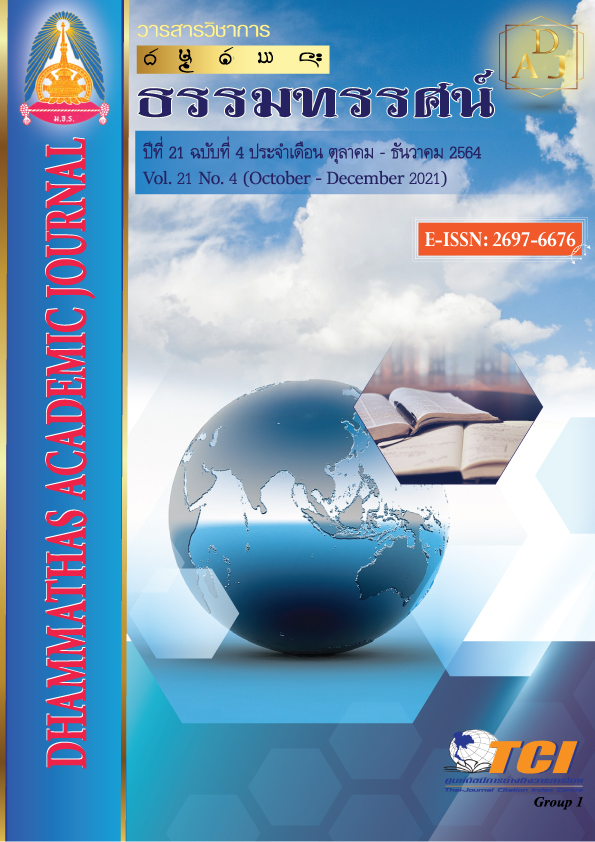Enhancing English Reading Comprehension Ability by Using Active Learning
Main Article Content
Abstract
The objectives of the study were to 1) compare the reading comprehension ability of the students between before and after using active learning; and 2) examine the undergraduate students’ satisfaction towardstheactive learning. The sample was 59 undergraduate students which were selected purposively. Instruments were active learning management plans (ALMP), a reading comprehension test, and a satisfaction questionnaire. The data was analyzed by percentages, mean, standard deviation, and t-test.
The results revealed as follows:
1. The reading ability scores after using active learning werehigher with a statistically significant difference at the level of 0.05.
2. The students werevery satisfied with the active learning ( = 4.26, S.D. = 0.18). The most satisfying aspect was ‘benefits of learning’ (
= 4.43, S.D. = 0.27) and the second and third were ‘activities (
= 4.21, S.D. = 0.30) and ‘learning atmosphere’ (
= 4.12, S.D. = 0.41) respectively.
Article Details
References
Afflerbach, P., Pearson, P. D., & Paris, S. G. (2008). Clarifying differences between reading skills and reading strategies. The Reading Teacher, 61(5), 364-373.
Claire, E. & Haynes, J. (1994). Classroom teacher’s ESL survival kit 1. Englewood Cliffs, NJ: Prentice Hall Regents.
Demirci, C. (2017). The effect of active learning approach on attitudes of 7th grade students. International Journal of Instruction, 10(4), 129-144.
Gimsoongneun, N. (2014). The model of organizing learning activities using participatory learning in community health nursing towards proficiency of nurse students, School of Nursing, Rangsit University. Journal of Rangsit University: Teaching & Learning, 8(2), 78-89.
Henard, F. & Roseveare, D. (2012). Fostering quality teaching in higher education: policies and practices. Paris: OECD Publishing.
Johnson, D. W., & Johnson, R. T. (2005). New developments in social interdependence theory. Psychology Monographs, 131(4), 285-358.
Johnson, D. W., Johnson, R. T., & Smith, K. A. (1991). Active learning: cooperation in the college classroom. Edina, MN: Interaction Book Company.
Ketpichainarong, W., & Sriwattanarothai, N. (2014). Active learning and technique for teaching and learning with focus on active learning. Bangkok: Institute for Innovative Learning, Mahidol University.
Kreusang, P. (2013). Techniques of teaching by active learning: experience from Shelton College International, Singapore. Nakhon Sawan: Nakhon Sawan Rajabhat University.
Meyer, C., & Jones, T. B. (1993). Promoting active learning: strategies for the college classroom. San Francisco, CA: Jossey-Bass.
Ministry of Education. (2019). A guidance for supervision for development and promotion of active learning management by following the reducing time for study and increasing time for knowing. Bangkok: Ministry of Education.
Moradi, S., Faghiharam, B., & Ghasempour, K. (2018). Relationship between group learning and interpersonal skills with emphasis on the role of mediating emotional intelligence among high school students. Retrieved from https://doi.org/10.1177/21582440187827344018782734
Narkprom, N., Poosiripinyo, V., & Saito, S. (2016). An investigation of English reading problems of 4th year English major students in the Faculty of Education, Phetchabun Rajabhat University. 3rd National Conference Phetchabun Rajabhat University.
Niyom, K. (2007). More than art, printmaking, and print. Bangkok: San Aksorn.
Office of the Educational Council. (2015). The education reform lab and coaching Lab (2014-2017): problems reflection and solutions 21 Century. Bangkok: Office of the Educational Council.
Pawachot, Y. (2020). The development of active learning activities combined with English communication skills training packages that promote learning achievement and creative thinking of Prathom Suksa 5 students. E-Journal of Education Studies, Burapha University, 2(4), 53-65.
Phonhan, P. (2017). Academic English reading strategies employed by Thai Chemistry students at undergraduate level with different reading proficiency. Kasetsart Journal - Social Sciences, 33(1), 1-12.
Prince, M. (2004). Does active learning work? A review of the research. Journal of Engineering Education, 93, 233-231.
Prontadavit, N. (2016). Active learning management. Bangkok: Tripping Education.
Surakarn, A. et al. (2020). Active learning and its outcomes: A case study from the education reform project in Thailand. The Journal of Behavioral Science, 15(1), 34-51.
Thatdee, N. (2018). The development of critical reading ability of Matthayomsuksa 3 students by using active learning. (Unpublished master’s thesis). Bangkok: Silpakorn University.
Tubarsa, S. (2019). The development of learning management model for the English 4 course by using active learning for enhancing reading skills for 8th grade students, BuaYai School. Nakhon Ratchasima: BuaYai School.
Wanner, T. (2015). Enhancing student engagement and active learning through just-in-time teaching and the use of PowerPoint. International Journal of Teaching and Learning in Higher Education, 27(1), 154-163.

